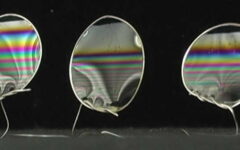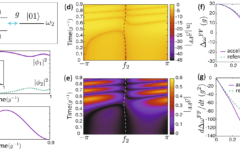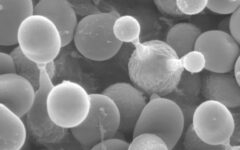Controlling chemical reactions with electrons: Quantum physics paves the way for new chemical products
16 August 2023 2023-08-16 11:07Controlling chemical reactions with electrons: Quantum physics paves the way for new chemical products

Controlling chemical reactions with electrons: Quantum physics paves the way for new chemical products
Source: Open University
Summary: New research reveals that electrons can control chemical reactions in experiments, potentially paving the way to purer, cheaper chemical products.
Observing these low energy electrons, physicists from both The Open University and Tata Institute of Fundamental Research, Mumbai, have discovered that chemical reactions can be controlled using electrons — rather than lasers, which are currently used — providing a much cheaper alternative to controlling chemical reactions. This has applications in the manufacturing of new chemical products that can be used in industry, including new drugs for cancer therapy and new electronics for computers.
Professor of Molecular Physics in the School of Physical Sciences at The Open University, Nigel Mason, is leading on the research; he said: “The ability to control chemical reactions is one of the major goals in chemistry; it would enable scientists and the manufacturing industry to reduce production costs and waste by targeting only the chemicals they want. The discovery that an electron rather than a laser can control the process means that this is approach is cheaper and faster.”
The experiments, carried out using a Velocity Map Imaging spectrometer built at the OU, were funded by through a visiting Fellowship of Professor Krishnakumar.
Related Posts
Frequency modulation accelerates the research of quantum technologies
Synchrotron sheds (X-ray) light on carbon chemistry at ocean surfaces
Physics of bubbles could explain language patterns
Frequency modulation accelerates the research of quantum technologies
Fungal spores harness physics to launch themselves
Search
Categories
- Acoustics (1)
- Admission (14)
- Alumni (19)
- Bacteria (1)
- Behavioral Science (1)
- Biochemistry (1)
- Biochemistry Research (1)
- Biology (1)
- Biotechnology (1)
- Blog (10)
- Botany (1)
- Career (14)
- Cell Biology (1)
- Chemistry (1)
- Chemistry (1)
- Developmental Biology (1)
- Epigenetics Research (1)
- Evolutionary Biology (1)
- Fungus (1)
- Fungus (1)
- Genetics (1)
- Health (1)
- Inorganic Chemistry (1)
- Life Sciences (1)
- Marine Biology (1)
- Mating and Breeding (1)
- Microbes and More (1)
- Microbiology (1)
- Molecular Biology (1)
- Nature of Water (1)
- News (39)
- Optics (1)
- Organic Chemistry (1)
- Physics (1)
- Prions (1)
- Prions (1)
- Quantum Computing (1)
- Quantum Physics (1)
- Research (38)
- Spotlight (15)
- Student life (15)
- Student story (13)
- Technology (1)
- Thermodynamics (1)
- Ultrasound (1)
- Uncategorized (10)
- Virology (1)
- Zika Virus Research (1)
- Zoology (1)
Get the latest University of Science, Technology and Arts news
Carborane-Cluster-Wrapped Copper Cluster with Cyclodextrin-like Cavities for Chiral Recognition | Journal of the American Chemical Society #Carborane #Cluster #Cu #Cyclodextrin #Chiral #Recognition
This week in #LCSOSynthesisProblem @DuncanBrownsey challenged us with the total synthesis of Wickerol A and B by Gui and coworkers @Jinghan_Gui in @J_A_C_S. #TotalSynthesis #Chemistry
Take a look: https://www.epfl.ch/labs/lcso/wp-content/uploads/2024/06/Wickerol-A-Gui-2020.pdf
Original paper: https://pubs.acs.org/doi/10.1021/jacs.9b11838
Modified Halloysite as Catalyst for the Conversion of Hydroxymethylfurfural to Furandicarboxylic Acid: A DFT Investigation (Dario Duca and co-workers)
Topological electride of 𝑡-YCl, Yiwei Liang, Xinyan Lin, Biao Wan, Zhaopeng Guo, Xuyan Cao, Dexi Shao, Jian Sun, and Huiyang Gou #CondensedMatter #ChemicalPhysics https://go.aps.org/3VwcMZ5
G-Quadruplex mRNAs Silencing with Inducible Ribonuclease Targeting Chimera for Precision Tumor Therapy | Journal of the American Chemical Society #Quadruplex #mRNA #Silencing #Ribonuclease #Chimera #Tumor #Therapy
Polycationic Open‐Shell Cyclophanes: Synthesis of Electron‐Rich Chiral Macrocycles, and Redox‐Dependent Electronic States – Shi – Angewandte Chemie International Edition – Wiley Online Library
Perspective on the Development of Monomer Recovery Technologies from Plastics Designed to Last
A Perspective by Steffan K. Kristensen, Troels Skrydstrup et al. @AarhusUni_int
🔓 Open access in ACS Organic & Inorganic Au 👉 https://go.acs.org/9Gv
A fantastic collection of activities to provoke and deepen mathematical thinking. ‘Thinkers’ will enhance the teaching and learning of mathematics for new and experienced teachers, and for learners from 8 to 18 (and beyond). http://bit.ly/ATMthinkers.
ICYMI, from our Emerging Investigators collection 🎉
‘Gold-catalyzed benzannulations of 2-alkenylindoles with alkynes: a protecting-group-free regioselective approach to carbazoles’ by Youliang Wang at Xi’an Jiaotong University.
Catalyst-Free α-trans-Selective Hydroboration and (E)-Selective Deuterated Semihydrogenation of Alkynyl Sulfones (@JOC_OL): https://pubs.acs.org/doi/10.1021/acs.joc.3c02833.
https://www.organic-chemistry.org/abstracts/lit3/936.shtm
A simple continuous hydrogenation of alkenes and alkynes with in situ generated diimide
Molecular Triplet Generation Enabled by Adjacent Metal Nanoparticles | Journal of the American Chemical Society #Triplet #Generation #Metal #Nanoparticles
Photonic implementation of the quantum Morra game, Andrés Ulibarrena, Alejandro Sopena, Russell Brooks, Daniel Centeno, Joseph Ho, Germán Sierra, and Alessandro Fedrizzi #Quantum #QuantumInformation https://go.aps.org/45eWCru
We’re excited to share our latest preprint on @ChemRxiv! The talented @Zhipengluu developed a new photo-active hypervalent iodine reagent for the diversification of aliphatic C–H bonds. Check it out: https://chemrxiv.org/engage/chemrxiv/article-details/665755b321291e5d1d8dfdbf
Now in @InorgChem! Read the article featuring pyrazine (pz)-bridged dinuclear Ru2(II,II) and Ru2(III,III) complexes and pz-containing mononuclear Ru(II) and Ru(III) complexes, which were afforded through the reactions of the (μ-Cl)3 Ru(II,II) complex: https://go.acs.org/9Gq
Long-Range Gating in Single-Molecule One-Dimensional Topological Insulators | Journal of the American Chemical Society @ColumbiaScience @Columbia @ChemColumbia @APAMMSECU #Gating #Topological #Insulators
Diastereo- and Enantioselective Construction of Stereochemical Arrays Exploiting Non-Classical Hydrogen Bonding in Enolborates (@ChemEurJ): https://chemistry-europe.onlinelibrary.wiley.com/doi/10.1002/chem.202401485.
A Review on the Recent Advances in Developing Radical Methods for the Synthesis of Aliphatic Sulfonyl Fluorides by Zhong-Yan Cao, Saihu Liao, and co-workers







